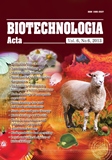ISSN 2410-776X (Online),
ISSN 2410-7751 (Print)

"Biotechnologia Acta" v. 6, no 6, 2013
https://doi.org/10.15407/biotech6.06.132
Р. 132-138, Bibliography 28, Russian.
Universal Decimal classification: 547.2:57.083:611.013.85
CREATION OF THE ОPTIMAL MEDIA FOR PLACENTAL TISSUE EXPLANTS CRYOPRESERVATION
Musatova I. B., Prokopyuk O. S., Volina V. V., Prokopyuk V. Yu.
Institute for Problems of Cryobiology and Cryomedicine of National Academy of Sciences of Ukraine, Kharkіv
Phase transitions and vitrification of multicomponent cryoprotective media including NaCl, dimethyl sulfoxide, sucrose, polyvinylpyrrolidone, dextran and hydroxyethylic starch for cryopreservation of explants of placental tissue as well as its morphological integrity after cryopreservation in these media with the aim of adequate selection of the components were studied by differential scanning calorimetry.
Analysis of the obtained thermograms has shown that in all multicomponent cryoprotective media, frozen with a high rate, the part of the solution transforms into a vitrified state during warming ice crystallization from amorphous phase and melting of solution area with eutectic composition are absent. Minimal intensity of endothermal effect of ice melting as well as the highest morphological integrity of placental tissue is observed in multicomponent solutions containing 5% dimethyl sulfoxide and 6,8% sucrose or 5% hydroxyethylic starch in physiological solution. These media should be considered as optimal ones for cryopreservation of placental tissue explants, and their composition is recommended to be used when designing complex cryoprotective media.
Key words: multicomponent solutions, phase transitions, vitrification, cryoprotectants, placental explants.
© Palladin Institute of Biochemistry of National Academy of Sciences of Ukraine, 2013
References
1. Farrant Dzh. Canning and vitrification. Kriobiologiya. 1988, N 2, P. 12–14. (In Russian).
2. Grishchenko V. I., Kalugin Yu. V., Luchko N. A. Ultrafast speed cooling and vitrification solution in Cryobiology. Probl. Kriobiol. 1993, N 3, P. 3–13. (In Russian).
3. Svedentsov E. P. Guide to Transfusion Medicine. Ed. E. P. Svedentsov. Kirov. 1999, 715 p. (In Russian).
4. Goff H. D., Caldwell K. B., Stenley D. W. The Influence of Polysaccharides on the Glass Transition in Frozen Sucrose Solutions and Ice Cream. J. Dairy Sci. 1993, N 76, P. 1268–1277.
5. Grishchenko V. I., Chuiko V. A., Pushkar N. S. Cryopreservation of tissues and cells of the endocrine organs. K.: Nauk. dumka. 1993, 242 p. (In Russian).
6. Tsutsaeva A. A., Agranenko V. A. Cryopreservation of cell suspensions. Ed. Tsutsaeva A. A. K.: Nauk. dumka. 1983, 240 p. (In Russian).
7. Vinograd-Finkel F. P., Kuselyov A. E. Actual problems of blood freezing. Probl. gematol. pereliv. krovi. 1970, N 4, P. 3–4. (In Russian).
8. Pushkar N. S., Itkin Yu. A., Bronshtein V. L. On the problem of dehydration and intracellular crystallization during freezing of cell suspension. Cryobiology. 1976, 13 (2), 147–152.
9. Smolyaninova E. I., Linnik T. P., Gordienko O. I. The permeability of the membrane of mouse oocytes to cryoprotectants series diol and amides. Tsitologiya. 2004, 46 (9), 855–856. (In Russian).
10. Ramazanov V. V., Bondarenko V. A. Manifestation and the elimination of the effect of "package" in environments with non-penetrating cryoprotectants and permeation. Probl. Kriobiol. 2009, 19 (3), 312–323. (In Russian).
11. Kuleshova L. L., Shaw J. M., Trounson A. O. Studies on replacing most of the penetrating cryoprotectant by polymers for embryo cryopreservation. Cryobiology. 2001, 43 (1), 21–31.
12. Kuleshova L. L., MacFarlane D. R., Trounson A. O., Shaw J. M. Sugars exert a major influence on the vitrification properties of ethylene glycol-based solutions and have low toxicity to embryos and oocytes. Cryobiology. 1999, 38 (2), 119–130.
13. Boutron P., Peyridieu J. F. Reduction in toxicity for red blood cells in buffered solutions contining high concentrations of 2,3-butanediol by trelahose, sucrose, sorbitol or mannitol. Cryobiology. 1994, V. 31, Р. 367–373.
14. Pegg D. E. The relevance of ice crystal formation for the cryopreservation of tissues and organs. Cryobiology. 2010, 60 (3), 36–44.
15. Huppertz J. B., Kivity V., Sammar M. Cryogenic and low temperature preservation of human placental villous explants — a new way to explore drugs in pregnancy disorders. Placenta. 2011, N 32, P. 65–76.
https://doi.org/10.1016/j.placenta.2010.11.020
16. Xiao Z., Wang Y., Li L. Needle immersed vitrification can lower the concentration of cryoprotectant in human ovarian tissue cryopreservation. Fert. Steril. 2010, 94 (6), 2323–2328.
http://dx.doi.org/10.1016/j.fertnstert.2010.01.011
17. Zinchenko A. V., Moiseev V. A. Investigation of the low-temperature phase transitions in aqueous solutions of PEG-400 calorimetric method. Kriobiol. kriomed. 1979, V. 5, P. 27–30. (In Russian).
18. Merkulpov G. A. The course of pathological histological techniques. L.: Medgiz. 1961, 340 p. (In Russian).
19. Rasmussen D. H., Mc Kenzie A. P. Phase diagramm for the system water-dimethylsulfoxide. Nature. 1968, 220 (5174), 1315–1317.
20. Remizova A. A. Phase transitions and anomalies near the melting point: Author. Dis .... kand. Sci. Sciences. Мoskva. 1960, 18 p. (In Russian).
21. Vorotilin A. M., Zinchenko A. V., Moiseev V. A., Podoprogora L. P. Mechanisms of damage of erythrocytes during defrosting. Kriobiologiya. 1990, N 3, P. 23–27. (In Russian).
22. Zinchenko A. V., Moiseev V. A., Ovcharenko F. D., Prokhvatilov A. I. Phase transitions and physical condition of the water-propanediol. DAN USSR. 1983, 269 (1), 144–146. (In Russian).
23. Han B., Bischof J. C. Thermodynamic nonequilibrium phase change behavior and thermal properties of biological solutions for cryobiology applications. J. Biomech. Eng. 2004, 126 (2), 196–203.
https://doi.org/10.1115/1.1688778
24. Zinchenko A. V., Petrenko A. Yu. Low-temperature phase transitions in the medium for cryopreservation of hepatocytes based on DMSO. Physical and chemical processes in cryobiological systems. Kharkiv. 1991, P. 56–60. (In Russian).
25. Schawe J. E. K. A quantitative DSC analysis of the metastable phase behavior of the sucrose-water system. Thermochimica Acta. 2006, 451 (1–2), 115–125.
https://doi.org/10.1016/j.tca.2006.09.015
26. Hatakeyama T., Tanaka M., Hatakeyama H. Thermal properties of freezing bound water restrained by polysaccharides. J. Biomater. Sci. Polym. Ed. 2010, 21 (14), 1865–1875.
27. Butrov A. V., Borisov A. Yu. Modern synthetic colloidal plasma substituting solutions in intensive therapy of acute blood loss. Consilium medikum (gastroenterolog / surgery). 2005, 7 (6), 472–476. (In Russian).
28. Serov V. N., Baranov I. I. HES solutions in obstetric practice. Ros. med. zhurn. 2006, 14 (1), 21–25. (In Russian).

